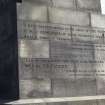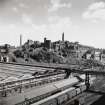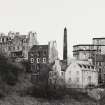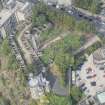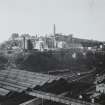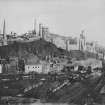Pricing Change
New pricing for orders of material from this site will come into place shortly. Charges for supply of digital images, digitisation on demand, prints and licensing will be altered.
Edinburgh, Waterloo Place, Old Calton Burial Ground, Martyrs' Monument
Commemorative Monument (19th Century), Obelisk (19th Century)
Site Name Edinburgh, Waterloo Place, Old Calton Burial Ground, Martyrs' Monument
Classification Commemorative Monument (19th Century), Obelisk (19th Century)
Alternative Name(s) Obelisk; Martyrs' Memorial
Canmore ID 117414
Site Number NT27SE 1331.01
NGR NT 26051 74007
Datum OSGB36 - NGR
Permalink http://canmore.org.uk/site/117414
- Council Edinburgh, City Of
- Parish Edinburgh (Edinburgh, City Of)
- Former Region Lothian
- Former District City Of Edinburgh
- Former County Midlothian
NT27SE 1331.01 26051 74007
Architect: Thomas Hamilton, 1844.
REFERENCE
National Library
'The Courant' - July 11, 1844; August 15, 1844; August 22,1844
(Undated) information in NMRS.
Project (1997)
The Public Monuments and Sculpture Association (http://www.pmsa.org.uk/) set up a National Recording Project in 1997 with the aim of making a survey of public monuments and sculpture in Britain ranging from medieval monuments to the most contemporary works. Information from the Edinburgh project was added to the RCAHMS database in October 2010 and again in 2012.
The PMSA (Public Monuments and Sculpture Association) Edinburgh Sculpture Project has been supported by Eastern Photocolour, Edinburgh College of Art, the Edinburgh World Heritage Trust, Historic Scotland, the Hope Scott Trust, The Old Edinburgh Club, the Pilgrim Trust, the RCAHMS, and the Scottish Archive Network.
Field Visit (7 March 2000)
Large plain obelisk carved with inscriptions.
Erected to commemorate the struggle for parliamentary reform.
On 16 January 1837 William Tait (bookseller) of 78 Princes Street, Edinburgh, wrote to the Lord Provost of Edinburgh: 'a meeting of Reformers has been advertised, as about to take place, Mr Joseph Hume M.P. in the chair; for the purpose of raising a subscription, throughout the country, for a monument to Messr Palmer, Gerrald, etc the Political Martyrs of 1793, 4, 5.' In his letter he states that 'it is the opinion of Mr Hume, and the members of the London Committee, that the place most appropriate for such a monument, is the Calton Hill of Edinburgh', and procedes to ask if the Town Council of Edinburgh will grant permission. On 27 January William Tait writes to the Plans and Works Committee of the Town Council of Edinburgh, informing them that the London Public Meeting was to take place on 20 February, and that 'it is Mr Hume's opinion that about 40 or 50 square feet of ground will be required; and he thinks that the monument will be in the form of a handsome obelisk.' In response to this letter, the Plans and Works Committee decided to 'express an opinion generally that a site should be granted for a monument of such character as would be an ornament to the city and as would not interfere with the usefulness of the Astronomical Institution, or with the appearance of any of the monuments already erected on the Calton Hill.' (1)
Thomas Muir (1765-1798), born in Glasgow and educated in Glasgow and Edinburgh. The formation of of the London Society of the Friends of the People led to a meeting on 16 October 1792 in Glasgow, for the creation of a kindred society for obtaining parliamentary reform. Muir spoke at this, and at subsequent meetings across Scotland, including the convention of delegates held in Edinburgh. On 2 January 1793 Muir was arrested on a charge of sedition. He was bailed and went to France, but returned to Scotland where he was again arrested and, on 30 August 1793, was tried in the Court of Justiciary for exciting a spirit of disloyalty and disaffection, of recommending Paine's 'Rights of Man', of distributing seditious writings, and of reading aloud a seditious writing. On 31 August he was convicted. In 1794 Muir, along with Thomas Fyshe Palmer (1747-1802), William Skirving and Maurice Margarot, was sent to Botany Bay.
Joseph Gerrald (1763-1796) was sent in 1793 as a delegate, with Maurice Margarot, from the London Corresponding Society to the 'British Convention of the Delegates of the People' in Edinburgh. The object of the convention was to obtain universal suffrage and annual parliaments. On 5 December 1793 Gerrald and Margarot were arrested for sedition. In May 1795, after spending a year in prison in London, Gerrald was also shipped to Botany Bay.
Inscriptions : On north face of pedestal (incised letters):
TO / THE MEMORY OF / THOMAS MUIR, / THOMAS FYSHE PALMER, / WILLIAM SKIRVING, / MAURICE MARGAROT / AND / JOSEPH GERRALD. / ERECTED BY THE FRIENDS OF PARLIAMENTARY REFORM IN ENGLAND AND SCOTLAND. 1844
On the west face (incised letters):
I HAVE DEVOTED MYSELF TO THE CAUSE OF THE PEOPLE. / IT IS A GOOD CAUSE - IT SHALL ULTIMATELY PREVAIL - IT / SHALL FINALLY TRIUMPH. / SPEECH OF THOMAS MUIR IN THE COURT OF / JUSTICIARY ON THE 30TH OF AUGUST 1793.
I KNOW THAT WHAT HAS BEEN DONE THESE TWO DAYS / WILL BE RE-JUDGED. / SPEECH OF WILLIAM SKIRVING IN THE COURT OF / JUSTICIARY ON THE 7TH OF JANUARY 1794.
Signatures : None Visible
Design period : 1837-1844
Year of unveiling : 1844
Information from Public Monuments and Sculpture Association (PMSA Work Ref : EDIN1395)












